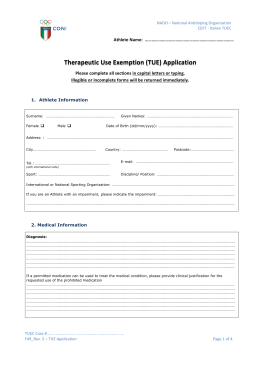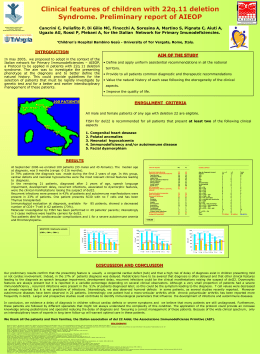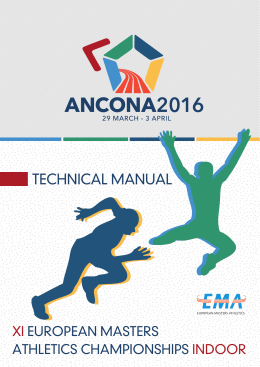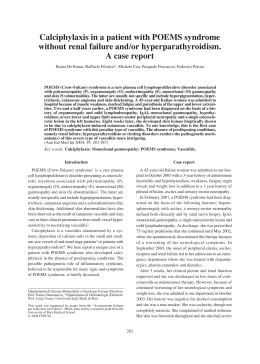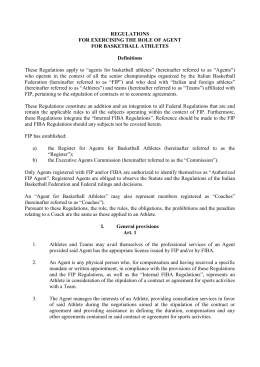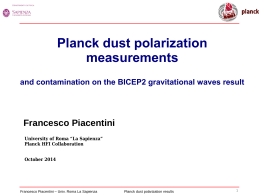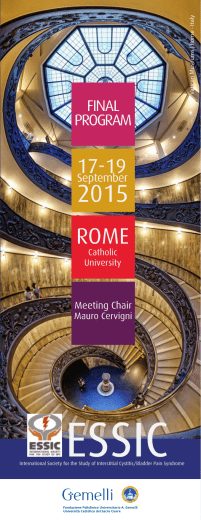Sistemi per la valutazione del recupero negli sport di resistenza Prof. Maria Francesca Piacentini Ph.D Università degli studi di Roma “Foro Italico” Monitorare…per prevenire © M.F. Piacentini! Monitorare…per capire quando riprendere allenamento © M.F. Piacentini! Monitorare…per garantire il picco prestativo nel momento che conta © M.F. Piacentini! New markers or early warning signals! POMS! Psychomotor speed ! ! , Rietjens et al. 2005; Nederhof et al 2006 Training diary data ! Foster 1998, Foster et al 2001, Van Loon et al. 2000, Piacentini et al. 2007! SpartaNova Model Piacentini et al. Accepted 2014 Piacentini et al. Accepted 2014 Piacentini et al. Accepted 2014 Piacentini et al. Accepted 2014 Piacentini et al. Accepted 2014 TL = Volume x RPE Piacentini et al. Accepted 2014 997% increase compared to baseline Piacentini et al. Accepted 2014 had been monitored continuously throughout the The multidisciplinary sports science team season, and values were normal with the exception of low ferritin (see Table III). Together with Jim’s After the initial meeting, a multidisciplinary sport descriptions of the symptoms and information from science team of experts was gathered together to from An elite endurance athlete’s recovery underperformance aided by his training log, the diagnosis was non-functional help Jim. aThe support team consisted of a sport multidisciplinary sport science support team overreaching. psychology consultant, a coach, an exercise physiol- Downloaded By: [Piacentini, Maria Francesca] At: 08:39 6 October 2008 ORIGINAL ARTICLE ogist, and a physician. The sport psychology conHENRIK GUSTAFSSON HANS-CHRISTER sultant (the first author) has a1,doctorate in sportHOLMBERG2, & PETER HASSMÉN3 Training programme and interventions science and has worked as a professional cross1 School of Health and Medical Sciences, Örebro University, Örebro, Sweden, 2Swedish Winter Research Center, Mid Sweden country skiing coach and assistant coachof Psychology, for the Stockholm Even if complete might be considered necessary University, Stockholm,rest Sweden University, Östersund, Sweden and 3Department Swedish junior national team. The coach has exin severe cases of underperformance, an active tensive experience at both junior and senior levels, as recovery with low-intensity training is frequently Abstract well as academic merits in sports medicine and sport considered superior to complete rest (Kellmann, Overload training resulting in an overreached state is common in elite sports, and if undetected can develop into an overtraining syndrome. This risk is accentuated by the lack of reliable measures of overreaching. Coaches and scientists therefore have to use a combination of tests in the monitoring process. This article presents a case study of the recovery from Table II. Test protocol underperformance of a young elite endurance athlete and the work of a multidisciplinary sport science support team. When it was determined that the athlete’s performance had deteriorated, and that this was due solely to the stress of training, Test 1 (pre) training load was radically reduced for a period of 14 days. A combination of physiological, Test 2 (mid) Test 3 (post) biochemical, and psychological measurements were then used to monitor the recovery process. The purpose of this article is to describe how coaches and sport science teams can help in monitoring training allowing early 15 signs of Day 1 Day 2and recovery in practical settings, Day 8 detection of theDay overreaching before a more serious overtraining syndrome develops. POMS ‘‘Test’’ roller skies POMS POMS Ten-step bounding Ten-step Keywords: Monitoring, mood, neuromuscular fatigue, overreaching, overtraining syndrome, perceived exertion, recovery bounding Sub-maximal cycle ergometry Sub-maximal cycle ergometry Blood tests Blood tests Note: RatingsIntroduction of form according to the Form Scale were conducedwithin in association training the whole period. 2 weeks,with andeach most often session within athroughout week Performance enhancement in elite sports requires that the athlete find a balance between training and recovery to avoid negative consequences such as underperformance and the onset of an overtraining syndrome. Elite athletes’ training loads have, however, increased dramatically during recent decades and the number of athletes experiencing negative instead of positive training responses seems to be on the rise as a consequence (Raglin & Wilson, 2000). This suggests that training and recovery are frequently not balanced, which is supported by a renewed interest in the recovery part of the training process (see Kellmann, 2002). Contrary to what some may believe, there is no clear line between normal adaptation to training and maladaptive training responses. The transition is (Kreider, Fry, & O’Toole, 1998; Smith, 2003). Depending on the outcome and the timing of recovery, overreaching can be considered functional or non-functional (Meuseen et al., 2006). If the long-term or non-functional overreached state is not counteracted by sufficient recovery, the athlete can progress into an overtraining syndrome, which leads to a condition of prolonged maladaptation through which stagnation or a decrease in performance may be sustained for several weeks or months (Gustafsson, Kenttä, Hassmén, Lundqvist, & Durand-Bush, 2007; Kreider et al., 1998). Overreaching and overtraining syndrome are complex phenomena and, despite substantial research efforts, the availability of diagnostic tools is still insufficient and no single reliable marker exists 14 day intervention ORIGINAL ARTICLE An elite endurance athlete’s recovery from underperformance aided by a multidisciplinary sport science support team HENRIK GUSTAFSSON1, HANS-CHRISTER HOLMBERG2, & PETER HASSMÉN3 1 School of Health and Medical Sciences, Örebro University, Örebro, Sweden, 2Swedish Winter Research Center, Mid Sweden University, Östersund, Sweden and 3Department of Psychology, Stockholm University, Stockholm, Sweden Downloaded By: [Piacentini, Maria Francesca] At: 08:39 6 October 2008 TMS Abstract Overload training resulting in an overreached state is common in elite sports, and if undetected can develop into an overtraining syndrome. This risk is accentuated by the lack of reliable measures of overreaching. Coaches and scientists therefore have 140to use a combination of tests in the monitoring process. This article presents a case study of the recovery from underperformance of a young elite endurance athlete and the work of a multidisciplinary sport science support team. When it was determined 120 that the athlete’s performance had deteriorated, and that this was due solely to the stress of training, training load was radically reduced for a period of 14 days. A combination of physiological, biochemical, and psychological measurements 100 were then used to monitor the recovery process. The purpose of this article is to describe how coaches and sport science teams can help in monitoring training and recovery in practical settings, allowing detection of the early signs of overreaching 80before a more serious overtraining syndrome develops. Keywords:60 Monitoring, mood, neuromuscular fatigue, overreaching, overtraining syndrome, perceived exertion, recovery 40 20 TMS within 2 weeks, and most often within a week (Kreider, Fry, & O’Toole, 1998; Smith, 2003). Performance enhancement in elite sports baseline Pre requires intervention Day 8 intervention Post intervention Depending on the outcome and the timing of that the athlete find a balance between training and recovery, overreaching can be considered functional recovery to avoid negative consequences such as or non-functional (Meuseen et al., 2006). If the underperformance and the onset of an overtraining long-term or non-functional overreached state is not syndrome. Elite athletes’ training loads have, howcounteracted by sufficient recovery, the athlete can ever, increased dramatically during recent decades progress into an overtraining syndrome, which leads and the number of athletes experiencing negative to a condition of prolonged maladaptation through instead of positive training responses seems to be on which stagnation or a decrease in performance may the rise as a consequence (Raglin & Wilson, 2000). be sustained for several weeks or months (GustafsThis suggests that training and recovery are freson, Kenttä, Hassmén, Lundqvist, & Durand-Bush, quently not balanced, which is supported by a 2007; Kreider et al., 1998). renewed interest in the recovery part of the training Overreaching and overtraining syndrome are comprocess (see Kellmann, 2002). plex phenomena and, despite substantial research Contrary to what some may believe, there is no efforts, the availability of diagnostic tools is still clear line between normal adaptation to training and insufficient and no single reliable marker exists maladaptive training responses. The transition is Introduction 0 14 day intervention TL reduction ORIGINAL ARTICLE An elite endurance athlete’s recovery from underperformance aided by a multidisciplinary sport science support team HENRIK GUSTAFSSON1, HANS-CHRISTER HOLMBERG2, & PETER HASSMÉN3 School of Health and Medical Sciences, Örebro University, Örebro, Sweden, 2Swedish Winter Research Center, Mid Sweden University, Östersund, Sweden and 3Department of Psychology, Stockholm University, Stockholm, Sweden Abstract Overload training resulting in an overreached state is common in elite sports, and if undetected can develop into an overtraining syndrome. This risk is accentuated by the lack of reliable measures of overreaching. Coaches and scientists therefore have to use a combination of tests in the monitoring process. This article presents a case study of the recovery from underperformance of a young elite endurance athlete and the work of a multidisciplinary sport science support team. When it was determined that the athlete’s performance had deteriorated, and that this was due solely to the stress of training,Recovery from underperformance 273 training load was radically reduced for a period of 14 days. A combination of physiological, biochemical, and psychological measurements were then used to monitor the recovery process. The purpose of this article is to describe how coaches and with the population norms (i.e. T50) for the POMS sport science teams can help in monitoring training 65 and recovery in practical settings, allowing detection of the early signs of (McNair et al., 1992). Research has shown that overreaching before a more serious overtraining syndrome develops. Tension 60 Depression 55 Fatigue Confusion athletes often display positive mental health with ‘‘an Anger Keywords: Monitoring, mood, neuromuscular fatigue, overreaching, overtraining syndrome, perceived exertion, recovery iceberg profile’’ meaning low negative scores (tenVigor T-score sion, anger, depression, and confusion) and high scores on vigour (Morgan, 1985). The implication is 50 that despite a significant increase in mood disturbanceaforweek the individual, his or her profile does look Introduction within 2 weeks, and most often within 45 normal2003). (Raglin, 1993). Thus, it is important to have (Kreider, Fry, & O’Toole, 1998; Smith, Performance enhancement in elite sports40 requires baseline Depending on the outcome and the timingvalues of to be able to monitor negative mood that the athlete find a balance between training and changes in athletes. recovery, overreaching can be considered functional recovery to avoid negative consequences35 such as Of the POMS variables, vigour might be or non-functional (Meuseen et al., 2006). If different the underperformance and the onset of an overtraining Test 1 long-term Testor 2 non-functional Test 3 overreached an state important indicator of maladaptation and nonis not syndrome. Elite athletes’ training loads have, howfunctional overreaching. In a comparison of the counteracted by sufficient the athlete can Figure decades 3. T-scores for POMS variables during test 1, testrecovery, 2, and ever, increased dramatically during recent baseline values, which were measured during a progress into an overtraining syndrome, which leads test 3. negative and the number of athletes experiencing normal training camp, and pre-study values, the to a condition of prolonged maladaptation through instead of positive training responses seems to be on fatigue score ratings 2000). of the legs but notstagnation for breathing. Heart rate which or a decrease in performance may was only slightly higher before the the rise as a consequence (Raglin & Wilson, intervention, but decreased after recovery. Vigour, was virtually unaffected during the 2-week intervenbe sustained for several weeks or months (GustafsThis suggests that training and recovery are freon the other tion, with the same average heart rate and differences son, Kenttä, Hassmén, Lundqvist, & Durand-Bush, hand, was still ‘‘high’’ during the quently not balanced, which is supported by a training camp but decreased during Jim’s overat each intensity ranging from 1et to beats (see 2007; Kreider al., 41998). renewed interest in the recovery part of the training reached state. During recovery, vigour again inTable III). Overreaching and overtraining syndrome are comprocess (see Kellmann, 2002). creased. In Jim rated his form as ‘‘normal’’ (0) and, whendespite completplex phenomena substantial researcha study of ultra-marathon runners, the Contrary to what some may believe, there is no athletes being full of energy despite reporthis first On day of2,diagnostic Jim efforts, thetest. availability tools isreported still clear line between normal adaptation toing training and sub-maximal ing heightened physical fatigue (Odagiri, Shimoon rollerand skisno andsingle estimated insufficient reliable marker exists maladaptive training responses. The performed transition ais test race mitsu, Iwane, & Katsumura, 1996). After 10 days this race as -2 (very, very bad form). On day 5, after : 08:39 6 October 2008 Downloaded By: [Piacentini, Maria Francesca] At: 08:39 6 October 2008 1 14 day intervention TL reduction ORIGINAL ARTICLE An elite endurance athlete’s recovery from underperformance aided by a multidisciplinary sport science support team HENRIK GUSTAFSSON1, HANS-CHRISTER HOLMBERG2, & PETER HASSMÉN3 School of Health and Medical Sciences, Örebro University, Örebro, Sweden, 2Swedish Winter Research Center, Mid Sweden University, Östersund, Sweden and 3Department of Psychology, Stockholm University, Stockholm, Sweden cortisol Abstract Overload training resulting in an overreached state is common in elite sports, and if undetected can develop into an overtraining syndrome. 450 This risk is accentuated by the lack of reliable measures of overreaching. Coaches and scientists therefore have to use a combination of tests in the monitoring process. This article presents a case study of the recovery from underperformance of a young elite endurance athlete and the work of a multidisciplinary sport science support team. When 400that the athlete’s performance had deteriorated, and that this was due solely to the stress of training, it was determined training load was radically reduced for a period of 14 days. A combination of physiological, biochemical, and psychological measurements were then used to monitor the recovery process. The purpose of this article is to describe how coaches and 350can help in monitoring training and recovery in practical settings, allowing detection of the early signs of sport science teams overreaching before a more serious overtraining syndrome develops. 300 Keywords: Monitoring, mood, neuromuscular fatigue, overreaching, overtraining syndrome, perceived exertion, recovery Nmol/l Downloaded By: [Piacentini, Maria Francesca] At: 08:39 6 October 2008 1 250 cortisol Introduction200 Performance enhancement in elite sports requires 150 that the athlete find a balance between training and recovery to avoid negative consequences such as 100 and the onset of an overtraining underperformance syndrome. Elite athletes’ training loads have, however, increased50 dramatically during recent decades and the number of athletes experiencing negative instead of positive training responses seems to be on 0 the rise as a consequence (Raglin & Wilson, 2000). PRE are freThis suggests that training and recovery quently not balanced, which is supported by a renewed interest in the recovery part of the training process (see Kellmann, 2002). Contrary to what some may believe, there is no clear line between normal adaptation to training and maladaptive training responses. The transition is within 2 weeks, and most often within a week (Kreider, Fry, & O’Toole, 1998; Smith, 2003). Depending on the outcome and the timing of recovery, overreaching can be considered functional or non-functional (Meuseen et al., 2006). If the long-term or non-functional overreached state is not counteracted by sufficient recovery, the athlete can progress into an overtraining syndrome, which leads to a condition of prolonged maladaptation through which stagnation or a decrease in performance may be sustained for POST several weeks or months (Gustafsson, Kenttä, Hassmén, Lundqvist, & Durand-Bush, 2007; Kreider et al., 1998). Overreaching and overtraining syndrome are complex phenomena and, despite substantial research efforts, the availability of diagnostic tools is still insufficient and no single reliable marker exists 14 day intervention TL reduction OVERTRAINING ¨ ¨ Studi che hanno portato atleti in condizioni di “overtraining” hanno evidenziato che c’è una differenza fra stress predetto e quello che viene chiamato “unpredictable stress” che ha effetti completamente differenti a livello centrale e periferico a parità di carico esterno L’atleta di alto livello sa gestirsi un blocco di allenamento più intenso. Quindi l’overtraining è qualcosa di differente dalla conseguenza di un carico troppo elevato © M.F. Piacentini Piacentini et al. 2014 RISULTATI Session-RPE negli atleti sub-elite e elite 1600 1600 * 1400 1400 * * Session1RPE 90 External:Load +#§ 80 60 1000 50 800800 40 600600 30 400400 20 200200 10 00 * different from 1 (P=0.000) + different from 2 (P=0.001) # different from 3 (P=0.000) § different from 4 (P=0.000) 0 11 22 33 44 Giorno Giorno 55 3000 3000 External 9Load 2500 2500 * different from 3 (P=0.000) + different from 4 (P=0.001) # different from 5 (P=0.000) *+#100 *# 2000 2000 80 1500 1500 60 1000 1000 40 500 500 20 Session)RPE Session)RPE Elite 120 Ses s i on0RPE 0 0 Carico0Esterno0(Km) Session)RPE 1000 Carico0Esterno0(Km) 1200 Session)RPE Sub-elite 70 1200 0 1 2 1 3 2 4 3 Session-RPE and Profile of Mood States during a training camp in elite and sub-elite triathletes 5 Giorno 4 5 Giorno 6 7 6 8 7 8 16 sub-elite: 17±1 anni 10 elite: 22±2 anni RISULTATI 20,0 18,0 *#+ * PRE # MID Punti 16,0 POST 14,0 12,0 POMS sub-elite * different from PRE (P=0.01) # different from MID (P=0.01) + different from POST(P=0.01) 10,0 8,0 6,0 4,0 2,0 0,0 Depression Fatigue Vigour Anger Tension PRE MID POST 20 18 POMS elite Punti 16 14 12 10 8 6 4 2 0 Depression Fatigue Vigour Session-RPE and Profile of Mood States during a training camp in elite and sub-elite triathletes Anger Tension 16 sub-elite: 17±1 anni 10 elite: 22±2 anni RISULTATI Energy,Index,(Vigore8Fatica) Energy Index negli atleti sub-elite e elite Sub!elite 15 Elite 10 * *# MID POST 5 0 !5 !10 PRE Somministrazione,POMS * difference from PRE for the sub-elite athletes (P<0.001) # difference from MID for the sub-elite athletes (P=0.000) Session-RPE and Profile of Mood States during a training camp in elite and sub-elite triathletes 16 sub-elite: 17±1 anni 10 elite: 22±2 anni Tapering! Il picco di prestazione si raggiunge modulando i carichi di lavoro ma una delle fasi più critiche nella programmazione dell’allenamento è proprio il periodo definito tapering! ! Sono state tante definizioni a “tapering”! Generalmente definito come una riduzione del carico totale di lavoro precedente alle gare importanti! © M.F. Piacentini! Scopo principale del Tapering! Miglioramenti durante questo periodo non solo fisiologici e prestativi ma anche psicologici con miglioramento dell’umore generale e del benessere sia fisico che mentale. POMS: diminuzione della fatica ed aumento del vigore Bompa 2009! © M.F. Piacentini! Scopo principale del Tapering Ma quanto deve durare? rischio di “detraining” rischio che non si recuperi a sufficienza © M.F. Piacentini Bompa 2009 Profile Of Mood States ¨ Fatica e vigore cambiano con i blocchi di allenamento 16 14 12 10 pre taper post taper 8 6 4 2 0 Fatigue Vigor © M.F. Piacentini Tension Piacentini et al Overreaching e Tapering L’overreaching prima del tapering è funzionale a portare l’atleta in supercompensazione ? © M.F. Piacentini Aubrey 2014 Coutts 2007 © M.F. Piacentini © M.F. Piacentini two-factor (condition, testing occasion) analysis of covariance (ANCOVA) with the pre-testing 3-km RTT time entered as a covariate to statistically adjust the post-test and post-taper 3-km RTT performance to take into account the pre-test differences. The results of the physiological, biochemistry and psychology tests were analyzed by a two-factor (condition, testing occasion) multivariate repeated measures analysis of variance. Changes in all variables were analyzed using both repeated and simple contrasts to determine the within group differences. An indepen- Training & Testing Coutts 2007 and creatinine levels. Catecholamines were extracted from urine, through a cation-exchange using Biorex resin and were then eluted from the resin and concentrated using alumina. Separation of catecholamines was by a High Performance Liquid Chromatography system using a reversed-phase C18 column and quantitated by integration of peak heights produced by an electrochemical detector (GBC Scientific Equipment Pty, Ltd., Vic, Australia). IENZE MOTORIE. Copyrighted material. Fig. 2 Percentage change (mean ± SD) in 3km run time trial performance for both the IT and NT groups; † significantly different amount of change from previous measure compared to the NT group (p < 0.05); ¥ significantly different amount of change from pre-training compared to the NT group (p < 0.05). Control group (n = 12) Pre TRAINING LOAD (% habitual load) 130% Post T1 100% 60% Baseline (I) (3 weeks) Phase III (3 weeks) Taper Phase II (1 week) Overload training group (n = 22) T2 T3 T4 T3 T4 Taper Phase IV (4 weeks) Post Pre 130% Overloading T1 T2 100% 60% Aubry 2014 Baseline (I) (3 weeks) Taper Phase II (1 week) Phase III (3 weeks) Taper Phase IV (4 weeks) POMS Energy Index 18" 16" 14" 12" 10" CONTROL" AF" 8" FOR" 6" 4" 2" 0" Pre"" Aubry 2014 Post" T1" T2" T3" T4" CONCLUSIONI! • Prevenzione dell’overreaching non funzionale! • Monitorare per comprendere gli adattamenti durante il tapering! • KIS: Keep it simple! • Monitorare a distanza! www.ecss-‐ congress.eu/2015 @ECSS2015 -‐ #ECSS2015
Scarica

